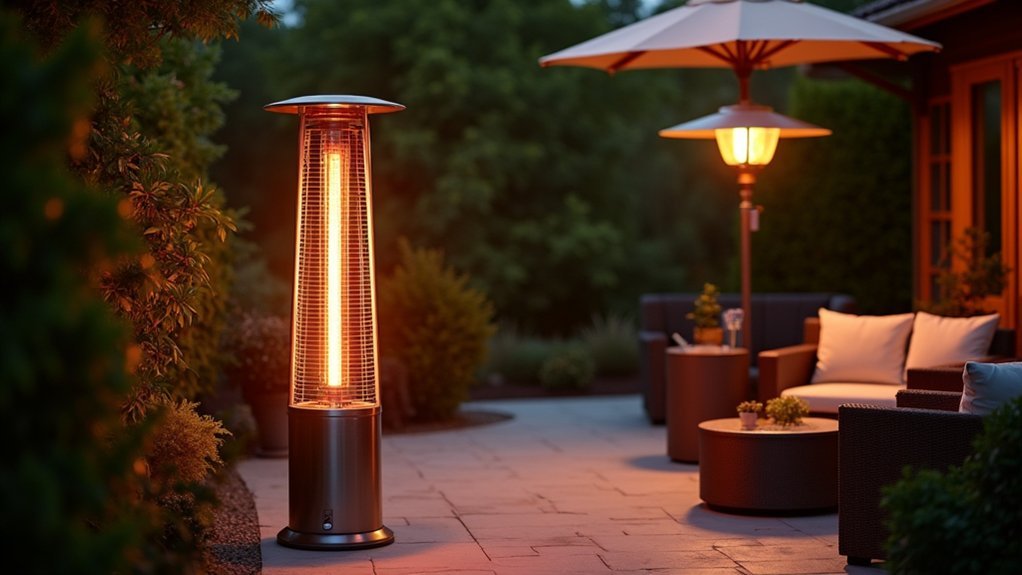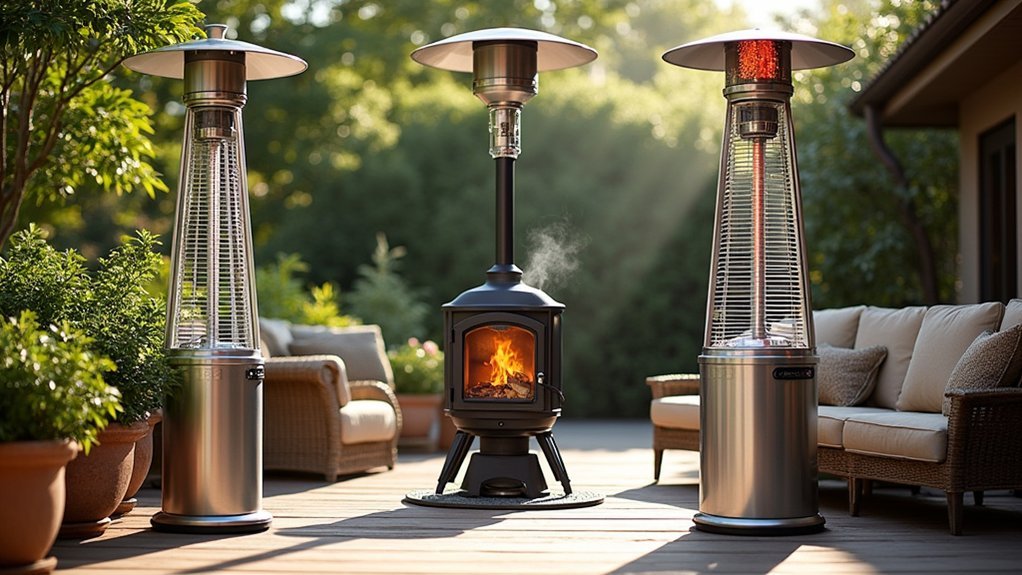You’ll find the biggest savings by choosing electric patio heaters over propane, saving $1.50-2.50 per hour in operating costs. Natural gas fire pits cost more upfront ($700-3,200) than wood-burning options ($200-1,200), but you’ll spend less long-term with $0.50-1.00 hourly rates versus $5-15 per fire. Infrared heating systems deliver the best value with 30% energy savings and 15-20 year lifespans. These comparisons reveal which outdoor heating investment works best for your budget and needs.
Electric Vs Propane Patio Heater Operating Expenses

When choosing between electric and propane patio heaters, you’ll find that operating costs differ markedly between the two options.
Electric patio heaters cost approximately $0.15 to $0.50 per hour, making them considerably cheaper for outdoor heating operations. In contrast, propane patio heaters require $2.00 to $3.00 hourly to operate, based on standard 20-pound propane tank consumption providing roughly 10 hours of use.
Electric patio heaters operate at $0.15-$0.50 per hour while propane units cost $2.00-$3.00 hourly, creating significant long-term savings differences.
While propane heaters generate around 40,000 BTUs for effective temperature increases, their operating expenses accumulate quickly through frequent tank refills.
Electric heaters offer superior efficiency in smaller spaces, particularly where electricity rates remain lower than propane prices.
Cost comparisons reveal that despite higher upfront purchases, electric units deliver substantial savings over time through reduced operating expenses, making them economically advantageous for long-term outdoor heating needs.
Natural Gas Vs Wood-Burning Fire Pit Investment Analysis
While natural gas fire pits demand a considerably higher upfront investment ranging from $700 to $3,200 including installation costs, wood-burning alternatives offer more accessible entry points between $200 and $1,200 for the unit alone.
| Factor | Natural Gas Fire Pits | Wood-Burning Fire Pits |
|---|---|---|
| Initial Investment | $700-$3,200 (with installation) | $200-$1,200 |
| Operating Costs | $0.50-$1.00 per hour | $5-$15 per fire |
| Convenience | Instant ignition, consistent heat output | Manual fire building, variable heat levels |
You’ll enjoy lower operating costs with natural gas, averaging under a dollar hourly versus wood’s $5-$15 per session. Natural gas offers superior convenience through instant ignition and consistent heat output, while wood-burning creates variable heat levels. Maintenance requirements differ greatly—natural gas needs minimal upkeep, whereas wood-burning demands regular ash removal. Longevity favors natural gas systems lasting decades compared to wood-burning units requiring replacement every 5-10 years.
Infrared Vs Traditional Heating System Long-Term Value

Although infrared heating systems require a substantial initial investment, they deliver exceptional long-term value through energy savings that can reach 30% compared to traditional forced-air systems.
You’ll experience lower operating costs since infrared heaters directly warm objects and people rather than heating air in outdoor spaces. These systems provide immediate warmth, reducing energy consumption during brief gatherings when traditional heating methods would waste energy warming up slowly.
Your maintenance costs stay minimal because infrared heaters contain fewer moving parts, eliminating frequent repairs that plague conventional systems.
Fewer moving parts mean minimal maintenance costs and virtually no repairs compared to complex conventional heating systems.
With lifespans reaching 15-20 years, you’ll avoid the replacement cycles common with traditional equipment. This combination of reduced energy consumption, minimal maintenance requirements, and extended durability makes infrared heating your smartest long-term investment for outdoor comfort.
Frequently Asked Questions
What Is the Most Cost-Effective Outdoor Heater?
You’ll find electric patio heaters most cost-effective, averaging $198 upfront with only electricity costs ongoing. They’re cheaper than propane heaters that cost $234 initially plus continuous fuel expenses from $20 tanks.
What Is the Most Energy-Efficient Outdoor Heating System?
Infrared patio heaters from brands like Bromic and Infratech are the most energy-efficient outdoor heating systems. They’ll heat objects directly rather than air, consuming less energy while providing quicker, more effective warmth.
How Long Will a 20 Lb Propane Tank Last in a Patio Heater?
You’ll get approximately 10 hours of heating from a 20-pound propane tank on high settings, though this varies based on your heater’s BTU output and environmental conditions.
What Is the Best Source of Heat for an Outdoor Patio?
You’ll get the best results with infrared heaters like Bromic or Infratech models. They’re more energy-efficient, warm objects directly instead of air, and provide superior performance in outdoor settings compared to traditional options.





Leave a Reply